Equity of Elderly Care Facility Allocation in a Multi-Ethnic City under the Aging Background
Abstract
1. Introduction
2. Materials and Methods
2.1. Study Area
2.2. Data
2.2.1. Data Sources
2.2.2. Web Crawler Technology
2.2.3. Entropy Method
2.2.4. Space Adaptation Analysis
3. Results and Discussion
3.1. Degree of Population Aging
3.1.1. Low Population Aging but High Density of the Elderly Population in Central Urban Areas
3.1.2. High Degree of Population Aging and High Dependency Burden for the Working Population in Ethnic Minority Communities
3.2. Service Level of Elderly Care Institutions
3.2.1. Status of Elderly Care Institutions in KM
3.2.2. Fundamental Service Level of Elderly Care Institutions
3.2.3. Comparison between State-Run and Privately Owned Elderly Care Institutions
3.2.4. Convenience Degree of Elderly Care Institutions
3.3. Coupling Coordination Degree
4. Conclusions
- (1)
- Elderly care resources should be allocated more equitably. More attention should be paid to ameliorating the unreasonable distribution of public infrastructure. Furthermore, the spatial distribution of the population should be managed via the rational layout of public infrastructure to alleviate excessive aging in the regional population.
- (2)
- The elderly care facilities in ethnic minority communities should be improved. Factors, including the economy, population, ethnic culture, and religious beliefs of ethnic minorities should be considered to construct elderly care institutions with suitable care types. The coverage, number of beds, and number of workers in state-run elderly care institutions should be improved. Considering the unique ethnic culture and ecological environment of ethnic minority communities, elderly care institutions can be developed in such a way to attract urban elders and stimulate the economy in ethnic minority areas, promoting the gradual improvement of elderly care facilities for ethnic minorities.
- (3)
- More public funds and resources should be allocated to ethnic minority communities to improve the equity of allocation. The planning and construction of elderly care institutions should also consider the characteristics of minority nationalities and accommodate the elderly’s care needs in terms of religious beliefs, dietary habits, interior decoration style, and customs to optimize elderly care for the ethnic minorities.
Author Contributions
Funding
Institutional Review Board Statement
Informed Consent Statement
Data Availability Statement
Conflicts of Interest
Appendix A
| No. | Full Name | Abbreviation | Administrative Districts |
|---|---|---|---|
| 1 | Kunming City | KM City | City |
| 2 | Anning City | AN City | County-level City |
| 3 | Songming County | SM County | County |
| 4 | Yiliang County | YL County | |
| 5 | Fumin County | FM County | |
| 6 | Panlong District | PL District | District |
| 7 | Wuhua District | WH District | |
| 8 | Guandu District | GD District | |
| 9 | Xishan District | XS District | |
| 10 | Dongchuan District | DC District | |
| 11 | Chenggong District | CG District | |
| 12 | Jinning District | JN District | |
| 13 | Shilin Yi Autonomous County | SL Autonomous County | Autonomous County |
| 14 | Xundian Hui Autonomous County | XD Autonomous County | |
| 15 | Luquan Miao Autonomous County | LQ Autonomous County | |
| 16 | Xiyang Yi Ethnic Township | XY Ethnic Township | Ethnic Township |
| 17 | Shuanghe Yi Ethnic Township | SH Ethnic Township | |
| 18 | Jiuxiang Yi and Hui Ethnic Township | JX Ethnic Township | |
| 19 | Gengjiaying Yi and Miao Ethnic Township | GJY Ethnic Township |
| The Range of D Value | Coupling Coordination Level | Meaning |
|---|---|---|
| (0.0–0.1) | 1 | extreme imbalance |
| [0.1–0.2) | 2 | high imbalance |
| [0.2–0.3) | 3 | moderate imbalance |
| [0.3–0.4) | 4 | slight imbalance |
| [0.4–0.5) | 5 | approaching imbalance |
| [0.5–0.6) | 6 | reluctant coordination |
| [0.6–0.7) | 7 | primary coordination |
| [0.7–0.8) | 8 | intermediate coordination |
| [0.8–0.9) | 9 | high coordination |
| [0.9–1.0) | 10 | quality coordination |
| No. | Coupling Degree C Value | Coordination Index T Value | Coupling Coordination Degree D Value | Level | Coupling Coordination Degree |
|---|---|---|---|---|---|
| 1 | 0.929 | 0.267 | 0.498 | 5 | approaching imbalance |
| 2 | 0.989 | 0.195 | 0.439 | 5 | approaching imbalance |
| 3 | 0.776 | 0.312 | 0.492 | 5 | approaching imbalance |
| 4 | 0.891 | 0.333 | 0.545 | 6 | reluctant coordination |
| 5 | 0.943 | 0.524 | 0.703 | 8 | intermediate coordination |
| 6 | 0.968 | 0.489 | 0.688 | 7 | primary coordination |
| 7 | 0.887 | 0.434 | 0.62 | 7 | primary coordination |
| 8 | 0.944 | 0.502 | 0.688 | 7 | primary coordination |
| 9 | 0.92 | 0.624 | 0.758 | 8 | intermediate coordination |
| 10 | 0.778 | 0.431 | 0.579 | 6 | reluctant coordination |
| 11 | 0.849 | 0.638 | 0.736 | 8 | intermediate coordination |
| 12 | 0.956 | 0.765 | 0.855 | 9 | high coordination |
| 13 | 0.951 | 0.613 | 0.764 | 8 | intermediate coordination |
| 14 | 0.978 | 0.584 | 0.756 | 8 | intermediate coordination |
| 15 | 0.983 | 0.665 | 0.808 | 9 | high coordination |
| 16 | 0.983 | 0.638 | 0.792 | 8 | intermediate coordination |
| 17 | 0.977 | 0.592 | 0.761 | 8 | intermediate coordination |
| 18 | 0.933 | 0.455 | 0.652 | 7 | primary coordination |
| 19 | 0.99 | 0.643 | 0.798 | 8 | intermediate coordination |
| 20 | 0.912 | 0.542 | 0.703 | 8 | intermediate coordination |
| 21 | 0.97 | 0.571 | 0.745 | 8 | intermediate coordination |
| 22 | 0.997 | 0.662 | 0.812 | 9 | high coordination |
| 23 | 0.975 | 0.592 | 0.76 | 8 | intermediate coordination |
| 24 | 0.969 | 0.616 | 0.773 | 8 | intermediate coordination |
| 25 | 0.967 | 0.626 | 0.778 | 8 | intermediate coordination |
| 26 | 0.987 | 0.666 | 0.811 | 9 | high coordination |
| 27 | 0.975 | 0.661 | 0.803 | 9 | high coordination |
| 28 | 0.955 | 0.624 | 0.772 | 8 | intermediate coordination |
| 29 | 0.92 | 0.527 | 0.696 | 7 | primary coordination |
| 30 | 0.982 | 0.658 | 0.804 | 9 | high coordination |
| 31 | 0.967 | 0.568 | 0.741 | 8 | intermediate coordination |
| 32 | 0.944 | 0.521 | 0.701 | 8 | intermediate coordination |
| 33 | 0.88 | 0.522 | 0.678 | 7 | primary coordination |
| 34 | 0.977 | 0.591 | 0.76 | 8 | intermediate coordination |
| 35 | 0.981 | 0.595 | 0.764 | 8 | intermediate coordination |
| 36 | 0.973 | 0.66 | 0.801 | 9 | high coordination |
| 37 | 0.954 | 0.616 | 0.766 | 8 | intermediate coordination |
| 38 | 0.95 | 0.527 | 0.708 | 8 | intermediate coordination |
| 39 | 0.971 | 0.588 | 0.756 | 8 | intermediate coordination |
| 40 | 0.886 | 0.458 | 0.637 | 7 | primary coordination |
| 41 | 0.983 | 0.626 | 0.784 | 8 | intermediate coordination |
| 42 | 0.94 | 0.463 | 0.66 | 7 | primary coordination |
| 43 | 0.94 | 0.529 | 0.705 | 8 | intermediate coordination |
| 44 | 0.947 | 0.562 | 0.729 | 8 | intermediate coordination |
| 45 | 0.855 | 0.586 | 0.708 | 8 | intermediate coordination |
| 46 | 0.972 | 0.604 | 0.766 | 8 | intermediate coordination |
| 47 | 0.967 | 0.602 | 0.763 | 8 | intermediate coordination |
| 48 | 0.911 | 0.57 | 0.721 | 8 | intermediate coordination |
| 49 | 0.981 | 0.585 | 0.757 | 8 | intermediate coordination |
| 50 | 0.975 | 0.611 | 0.771 | 8 | intermediate coordination |
| 51 | 0.992 | 0.662 | 0.81 | 9 | high coordination |
| 52 | 0.954 | 0.568 | 0.736 | 8 | intermediate coordination |
| 53 | 0.631 | 0.045 | 0.168 | 2 | high imbalance |
| 54 | 0.572 | 0.056 | 0.178 | 2 | high imbalance |
| 55 | 0.554 | 0.06 | 0.182 | 2 | high imbalance |
| 56 | 0.597 | 0.05 | 0.174 | 2 | high imbalance |
| 57 | 0.941 | 0.015 | 0.119 | 2 | high imbalance |
| 58 | 0.266 | 0.278 | 0.272 | 3 | moderate imbalance |
| 59 | 0.263 | 0.284 | 0.273 | 3 | moderate imbalance |
| 60 | 0.287 | 0.237 | 0.261 | 3 | moderate imbalance |
| 61 | 0.321 | 0.189 | 0.246 | 3 | moderate imbalance |
| 62 | 0.228 | 0.379 | 0.294 | 3 | moderate imbalance |
| 63 | 0.303 | 0.213 | 0.254 | 3 | moderate imbalance |
| 64 | 0.403 | 0.118 | 0.218 | 3 | moderate imbalance |
| 65 | 0.333 | 0.175 | 0.242 | 3 | moderate imbalance |
| 66 | 0.313 | 0.2 | 0.25 | 3 | moderate imbalance |
| 67 | 0.24 | 0.342 | 0.287 | 3 | moderate imbalance |
| 68 | 0.199 | 0.5 | 0.315 | 4 | slight imbalance |
| 69 | 0.259 | 0.293 | 0.276 | 3 | moderate imbalance |
| 70 | 0.375 | 0.137 | 0.227 | 3 | moderate imbalance |
| 71 | 0.264 | 0.281 | 0.273 | 3 | moderate imbalance |
| 72 | 0.283 | 0.245 | 0.263 | 3 | moderate imbalance |
| 73 | 0.202 | 0.484 | 0.313 | 4 | slight imbalance |
| 74 | 0.243 | 0.334 | 0.285 | 3 | moderate imbalance |
| 75 | 0.296 | 0.223 | 0.257 | 3 | moderate imbalance |
| 76 | 0.651 | 0.042 | 0.164 | 2 | high imbalance |
| 77 | 0.408 | 0.115 | 0.216 | 3 | moderate imbalance |
| 78 | 0.477 | 0.082 | 0.198 | 2 | high imbalance |
| 79 | 0.506 | 0.073 | 0.192 | 2 | high imbalance |
| 80 | 0.617 | 0.047 | 0.17 | 2 | high imbalance |
| 81 | 0.391 | 0.125 | 0.222 | 3 | moderate imbalance |
| 82 | 0.384 | 0.13 | 0.224 | 3 | moderate imbalance |
| 83 | 0.43 | 0.103 | 0.21 | 3 | moderate imbalance |
| 84 | 0.517 | 0.07 | 0.19 | 2 | high imbalance |
| 85 | 0.436 | 0.1 | 0.209 | 3 | moderate imbalance |
| 86 | 0.474 | 0.084 | 0.199 | 2 | high imbalance |
| 87 | 0.548 | 0.061 | 0.183 | 2 | high imbalance |
| 88 | 0.549 | 0.061 | 0.183 | 2 | high imbalance |
| 89 | 0.649 | 0.042 | 0.165 | 2 | high imbalance |
| 90 | 0.595 | 0.051 | 0.174 | 2 | high imbalance |
| 91 | 0.457 | 0.091 | 0.203 | 3 | moderate imbalance |
| 92 | 0.755 | 0.029 | 0.148 | 2 | high imbalance |
| 93 | 0.471 | 0.085 | 0.2 | 2 | high imbalance |
| 94 | 0.64 | 0.043 | 0.166 | 2 | high imbalance |
| 95 | 0.41 | 0.114 | 0.216 | 3 | moderate imbalance |
| 96 | 1 | 0.01 | 0.1 | 2 | high imbalance |
| 97 | 0.363 | 0.146 | 0.231 | 3 | moderate imbalance |
| 98 | 0.431 | 0.102 | 0.21 | 3 | moderate imbalance |
| 99 | 0.478 | 0.082 | 0.198 | 2 | high imbalance |
| 100 | 0.435 | 0.1 | 0.209 | 3 | moderate imbalance |
| 101 | 0.352 | 0.156 | 0.234 | 3 | moderate imbalance |
| 102 | 0.502 | 0.074 | 0.193 | 2 | high imbalance |
| 103 | 0.34 | 0.168 | 0.239 | 3 | moderate imbalance |
| 104 | 0.344 | 0.164 | 0.237 | 3 | moderate imbalance |
| 105 | 0.314 | 0.197 | 0.249 | 3 | moderate imbalance |
| 106 | 0.359 | 0.15 | 0.232 | 3 | moderate imbalance |
| 107 | 0.313 | 0.2 | 0.25 | 3 | moderate imbalance |
| 108 | 0.556 | 0.059 | 0.182 | 2 | high imbalance |
| 109 | 0.328 | 0.181 | 0.244 | 3 | moderate imbalance |
| 110 | 0.457 | 0.09 | 0.203 | 3 | moderate imbalance |
| 111 | 0.395 | 0.123 | 0.22 | 3 | moderate imbalance |
| 112 | 0.314 | 0.198 | 0.249 | 3 | moderate imbalance |
| 113 | 0.347 | 0.161 | 0.236 | 3 | moderate imbalance |
| 114 | 0.346 | 0.162 | 0.237 | 3 | moderate imbalance |
| 115 | 0.408 | 0.115 | 0.217 | 3 | moderate imbalance |
| 116 | 0.468 | 0.086 | 0.201 | 3 | moderate imbalance |
| 117 | 0.481 | 0.081 | 0.198 | 2 | high imbalance |
| 118 | 0.395 | 0.123 | 0.22 | 3 | moderate imbalance |
| 119 | 0.856 | 0.021 | 0.133 | 2 | high imbalance |
| 120 | 0.461 | 0.089 | 0.202 | 3 | moderate imbalance |
| 121 | 0.397 | 0.121 | 0.22 | 3 | moderate imbalance |
| 122 | 0.409 | 0.115 | 0.216 | 3 | moderate imbalance |
| 123 | 0.476 | 0.083 | 0.199 | 2 | high imbalance |
| 124 | 0.381 | 0.132 | 0.225 | 3 | moderate imbalance |
| 125 | 0.611 | 0.048 | 0.171 | 2 | high imbalance |
| 126 | 0.283 | 0.245 | 0.263 | 3 | moderate imbalance |
| 127 | 0.473 | 0.084 | 0.2 | 2 | high imbalance |
| 128 | 0.399 | 0.12 | 0.219 | 3 | moderate imbalance |
| 129 | 0.482 | 0.081 | 0.197 | 2 | high imbalance |
| 130 | 0.389 | 0.127 | 0.222 | 3 | moderate imbalance |
| 131 | 0.41 | 0.114 | 0.216 | 3 | moderate imbalance |
| 132 | 0.314 | 0.198 | 0.249 | 3 | moderate imbalance |
References
- The Seventh National Census of China in 2021. National Bureau of Statistics of China. 2021. Available online: http://www.stats.gov.cn/ (accessed on 5 October 2022).
- Mutchler, J.E.; Li, Y.; Xu, P. How strong is the Social Security safety net? Using the Elder Index to assess gaps in economic security. J. Aging Soc. Policy 2019, 31, 123–137. [Google Scholar] [CrossRef]
- Ethnic and Religious Affairs Commission of Yunnan Province. 2021. Available online: https://mzzj.yn.gov.cn/ (accessed on 15 January 2023).
- Nishino, T.; Kasai, S. Development of a location optimization planning framework for care facilities based on estimation of distribution of senior people on GIS. J. Archit. Build. Sci. 2019, 25, 813–818. [Google Scholar] [CrossRef]
- Ozawa, W.; Yano, K.; Tomoki, N.; Kato, H. On Geographical Information System for Observing Support Activities Regarding Aged Solitary People in Kyoto City: Part 2. Ritsumeikan Soc. Sci. Rev. 2020, 56, 109–129. [Google Scholar] [CrossRef]
- Nishimura, J.; Inoue, K.; Tanaka, T.; Matsuo, K.; Yokoyama, M. Research on the influence of street characteristics on pedestrian volume in the domination area of a regional central city. J. City Plan. Inst. Jpn. 2021, 56, 485–492. [Google Scholar] [CrossRef]
- Moriya, K.; Tokunaga, Y. A Study on Social Benefits Evaluation Method for Regional Public Transportation Planning Considering Generational Differences. City Plan. Rev. 2021, 20, 73–78. [Google Scholar] [CrossRef]
- Kusunoki, K.; Yoshikawa, T. Analysis of trends in the distribution of ling-term care beds and psychiatric beds in secondary and first medical areas. City Plan. Rev. 2020, 18, 363–368. [Google Scholar] [CrossRef] [PubMed]
- Takahashi, N.; Nagaie, T.; Miyatake, M. A Study on the Variation of Evacuation time considering with snow cover in tsunami disaster. J. Jpn. Soc. Civ. Eng. Ser. B3 Ocean. Eng. 2020, 76, I_1013–I_1018. [Google Scholar] [CrossRef] [PubMed]
- Dosen, K.M.; Karasiuk, A.A.; Marcaccio, A.C.; Miljak, S.; Nair, M.H.; Radauskas, V.J. Code grey: Mapping healthcare service deserts in Hamilton, Ontario and the impact on senior populations. Cartogr. Int. J. Geogr. Inf. Geovis. 2017, 52, 125–131. [Google Scholar] [CrossRef]
- Wang, J.; Kwan, M.P. Hexagon-based adaptive crystal growth Voronoi diagrams based on weighted planes for service area delimitation. ISPRS Int. J. Geo-Inf. 2018, 7, 257. [Google Scholar] [CrossRef]
- Ngui, A.N.; Apparicio, P. Optimizing the two-step floating catchment area method for measuring spatial accessibility to medical clinics in Montreal. BMC Health Serv. Res. 2011, 11, 166. [Google Scholar] [CrossRef] [PubMed]
- Yu, S.; Li, W. Research on the application of GIS in the problem of aging. In Proceedings of the 2019 4th International Conference on Humanities Science and Society Development, Xiamen, China, 24 May 2019; pp. 279–282. [Google Scholar] [CrossRef]
- Yu, B.J.; Cui, X.; Liu, X.Y.; Cheng, Y. Accessibility Research and Spatial Distribution Characteristics of Residential Care Facilities in Chengdu: Based on Two-step Floating Catchment Area Method. Huazhong Archit. 2022, 40, 83–87. [Google Scholar] [CrossRef]
- Li, S.H.; Song, Q.Q.; Wan, S. Research on the Site Selection of Endowment Real Estate Project Based on GIS—Take Tianjin City as an Example. J. Tianjin Univ. Soc. Sci. 2017, 19, 204–209. [Google Scholar] [CrossRef]
- Yan, H.; Luo, Z.F.; Sun, Y.; Tang, X.L.; Yang, J. Planning Site Selection of Services for the Elders Based on POI Data in Changsha City. J. Shaoguan Univ. Nat. Sci. 2022, 43, 86–90. [Google Scholar] [CrossRef]
- Xu, Y.S.; Zhou, D.; Qiu, Z.W.; Li, Z. A Study on the Planning and Layout of Care Facilities Based on Spatial Distributive Characteristics of the Elderly People. Archit. J. 2017, 9, 74–77. [Google Scholar] [CrossRef]
- Chen, L.; Chen, Z.; Qiu, C.S.; Chen, W.D. Research on the Distribution, Operation Status and Countermeasures of Pension Institutions from the Perspective of Industry Development: A Case Study of Chengdu. Urban Rural Plan. 2021, Z1, 165–174. [Google Scholar] [CrossRef]
- Ji, Y.Q.; Jiang, H.M. Spatial and Temporal Differences and Influencing Factors of the Adaptation Degree of Aging and Pension Resources in the New Era. Sci. Geogr. Sin. 2022, 42, 854–862. [Google Scholar] [CrossRef]
- Zhao, P.J.; Luo, J.; Hu, H.Y. Character of the Elderly’s Life Circle and Public Service. Facilities Configuration by Using Big Data: A Case of Beijing. Sci. Geogr. Sin. 2022. Available online: https://kns.cnki.net/kcms/detail/22.1124.P.20220809.1537.010.html (accessed on 11 August 2022).
- Guo, J.X.; Zhang, S.; Liu, H. Research on Location Allocation of Community Pension Service Facilities from the Perspective of Life Circle: A Case Study of Nankai District, Tianjin. J. Tianjin Chengjian Univ. 2022, 28, 6–12. [Google Scholar] [CrossRef]
- Xu, X.J. Research on Accessibility Evaluation of Community Elderly Care Service Facilities in Guang-zhou from Perspective of Community Differentiation. Urban Archit. Space 2022, 29, 98–101. [Google Scholar] [CrossRef]
- Zhao, Y.; Xu, F.; Wan, Y.L. Spatial Accessibility and Supply-demand Balance Analysis Method of Park Green Space based on Modified Gravity Model. J. Geo-Inf. Sci. 2022. Available online: https://kns.cnki.net/kcms/detail/11.5809.P.20220808.1651.002.html (accessed on 9 August 2022).
- Aziz, A.; Li, J.; Hu, S.; Hu, R. Spatial accessibility of township to county hospital and its disparity among age and urbanizing groups in Anhui, China-a GIS analysis. Comput. Urban Sci. 2022, 2, 9. [Google Scholar] [CrossRef]
- Chen, L.; Guo, W.; Perez, C. Social support and life satisfaction of ethnic minority elderly in China. Int. J. Aging Hum. Dev. 2019, 92, 301–321. [Google Scholar] [CrossRef] [PubMed]
- Ran, L.; Jiang, X.; Li, B.; Kong, H.; Du, M.; Wang, X.; Liu, Q. Association among activities of daily living, instrumental activities of daily living and health-related quality of life in elderly Yi ethnic minority. BMC Geriatr. 2017, 17, 74. [Google Scholar] [CrossRef] [PubMed]
- Chen, Z.S.; Liu, X.L.; Chin, K.S.; Pedrycz, W.; Tsui, K.L.; Skibniewski, M.J. Online-review analysis based large-scale group decision-making for determining passenger demands and evaluating passenger satisfaction: Case study of high-speed rail system in China. Inf. Fusion 2021, 69, 22–39. [Google Scholar] [CrossRef]
- Zhang, H.F.; Yang, F.T.; Jin, Q.L. Public Cultural Services and High-Quality Economic Development Policy Implications Based on Coupling Coordination Degree Model. Rev. Econ. Manag. 2022, 38, 58–70. [Google Scholar] [CrossRef]
- Wang, D.; Jiang, D.; Fu, J.; Lin, G.; Zhang, J. Comprehensive assessment of production–living–ecological space based on the coupling coordination degree model. Sustainability 2020, 12, 2009. [Google Scholar] [CrossRef]
- Osaka Prefectural Plan for Senior Citizens 2021. Osaka Prefectural Government. 2022. Available online: https://www.pref.osaka.lg.jp/kaigoshien/keikaku/index.html (accessed on 8 November 2022).
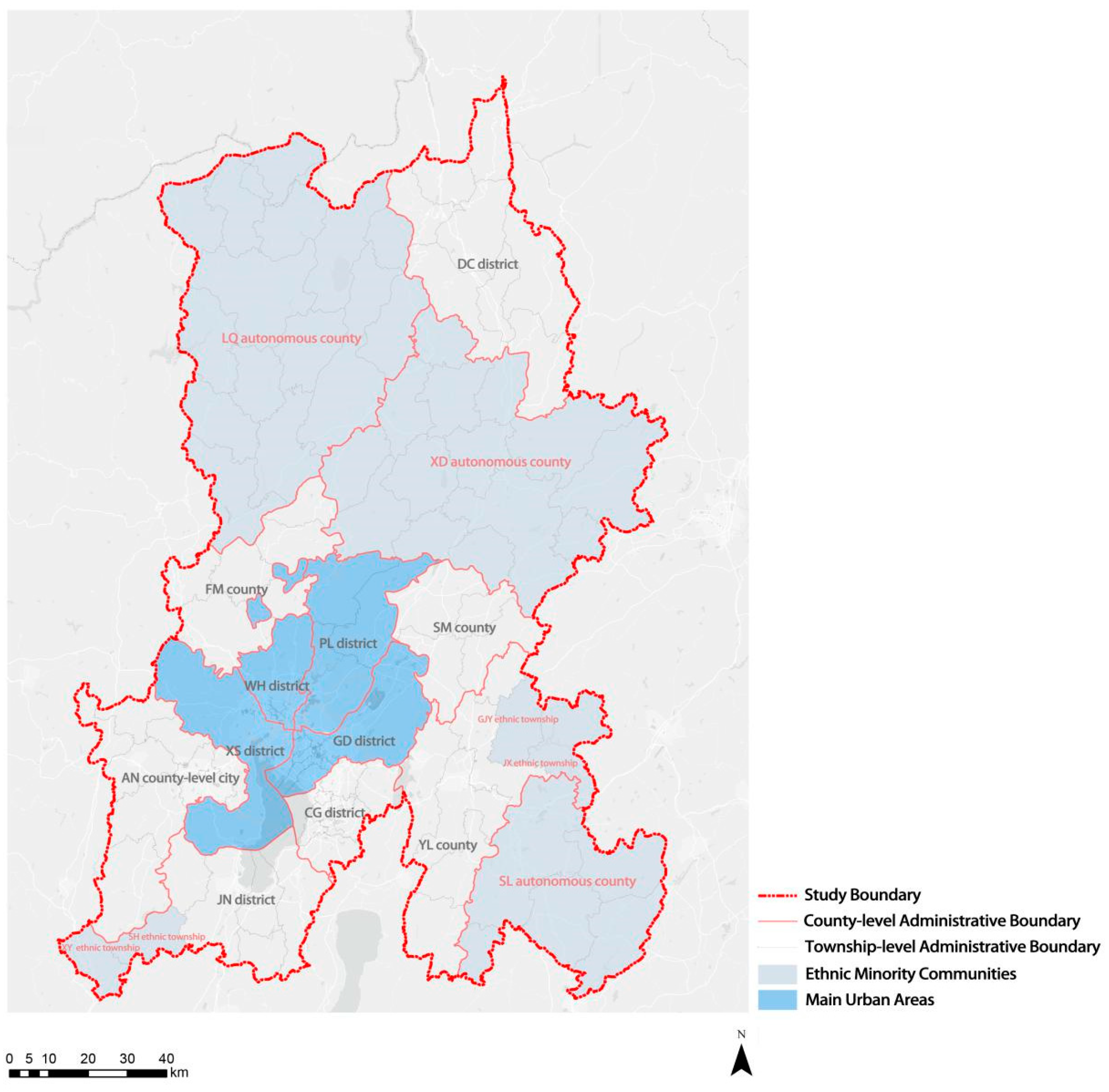
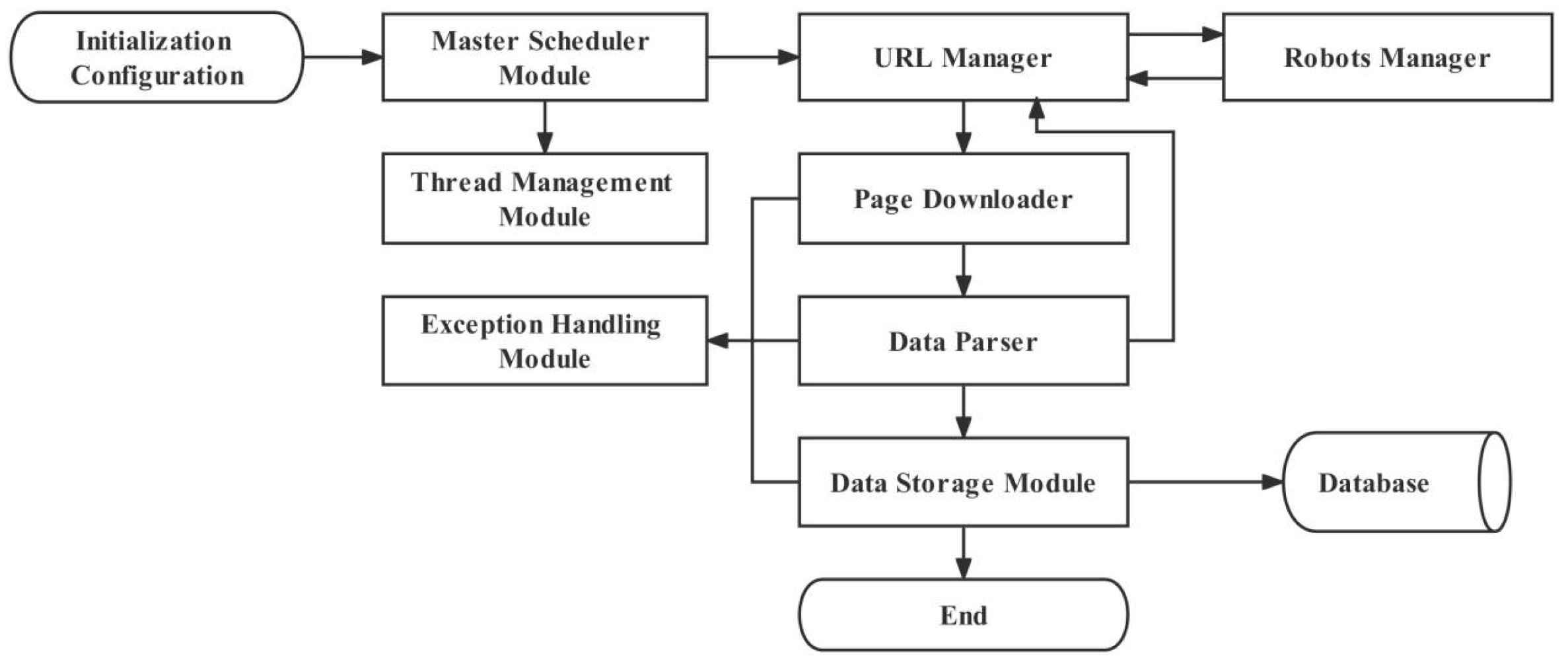

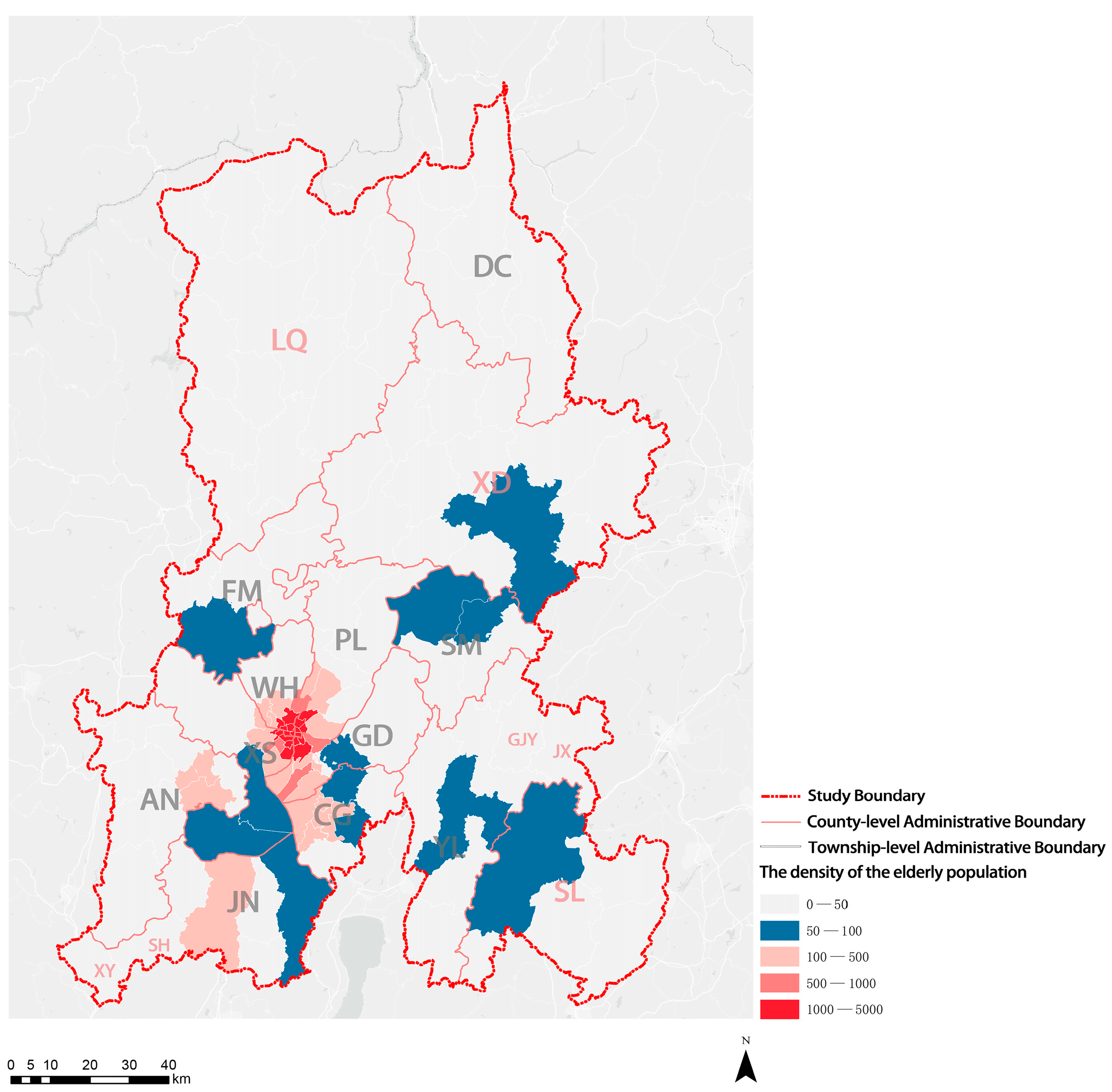
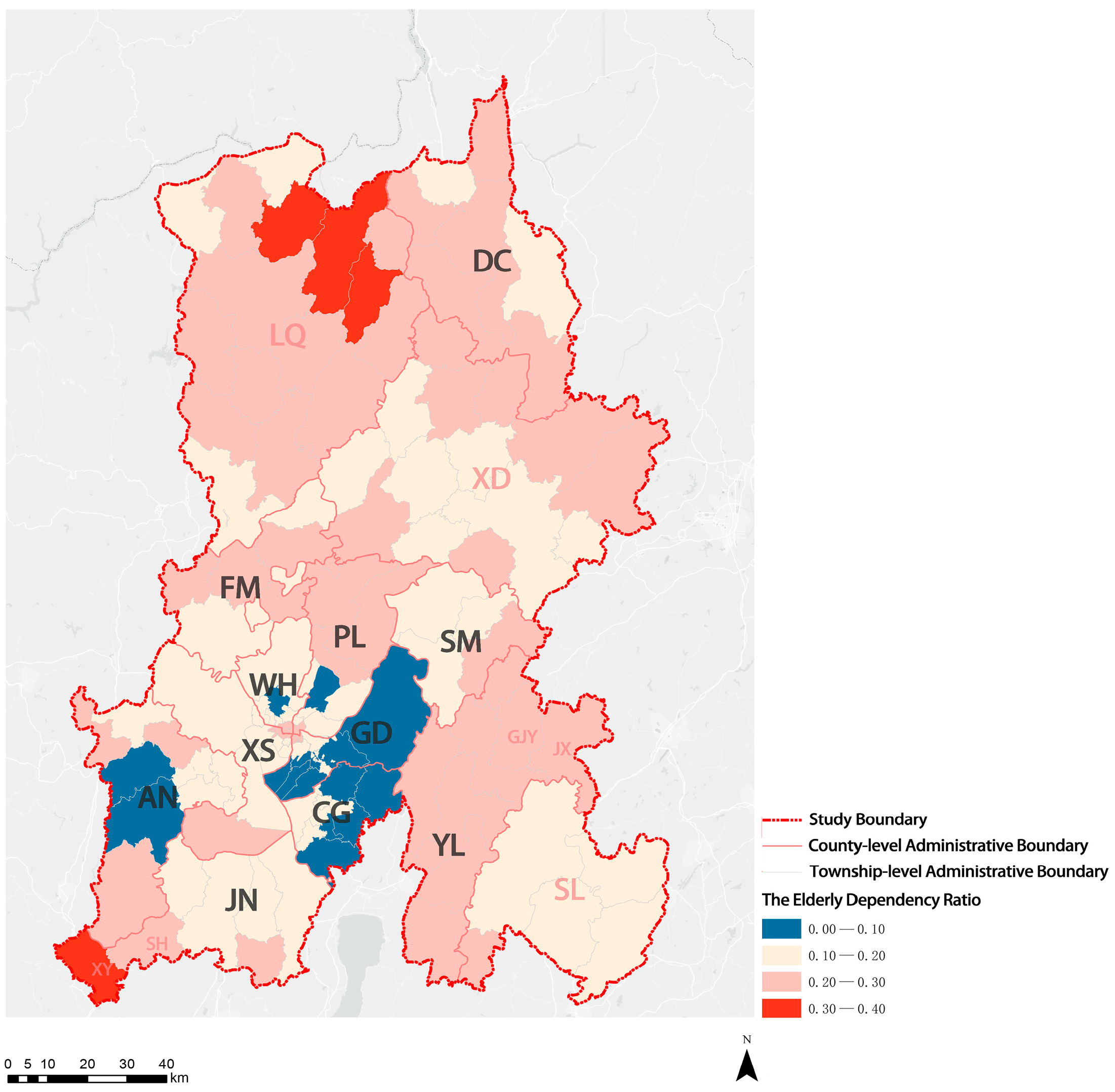
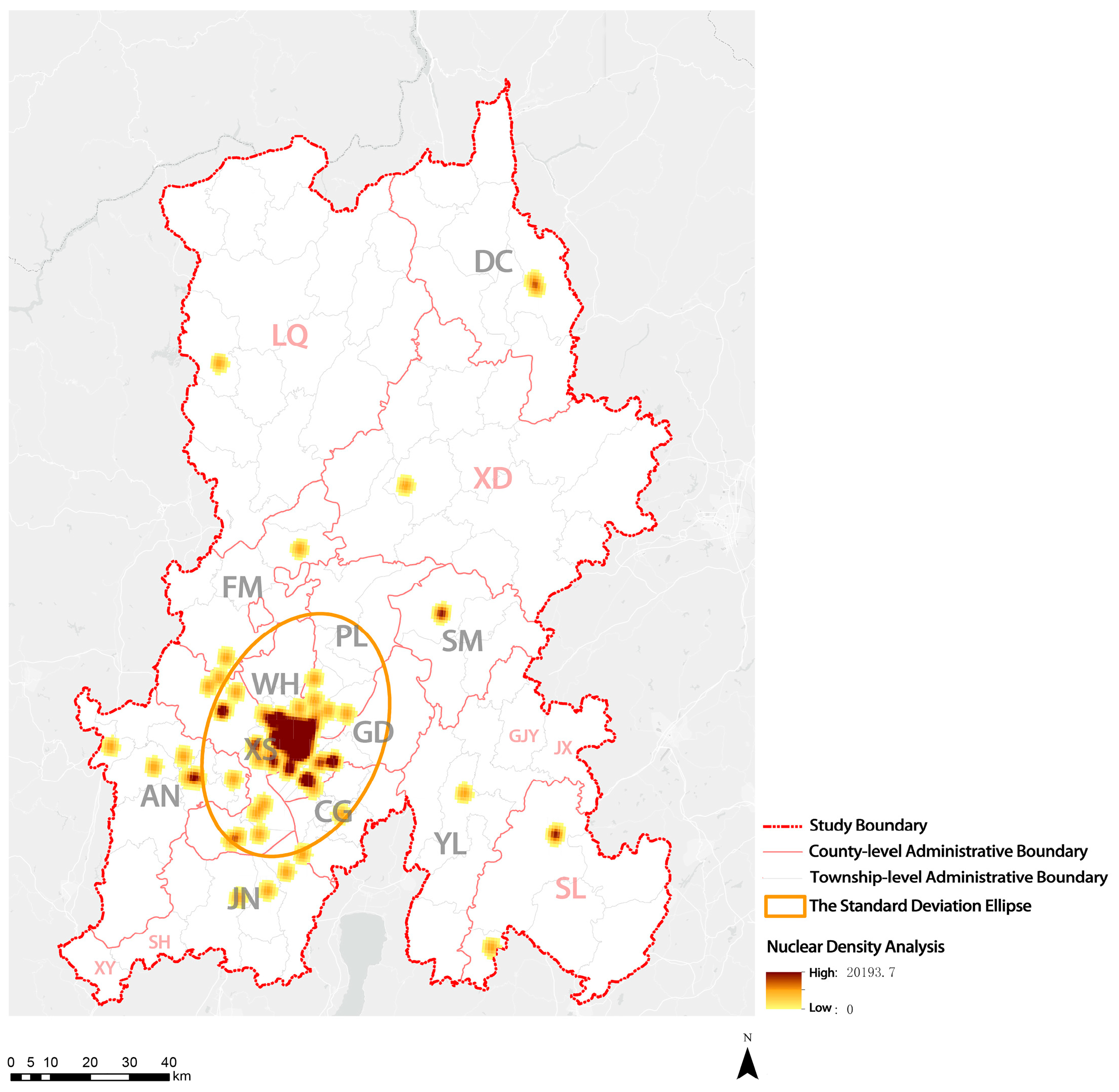
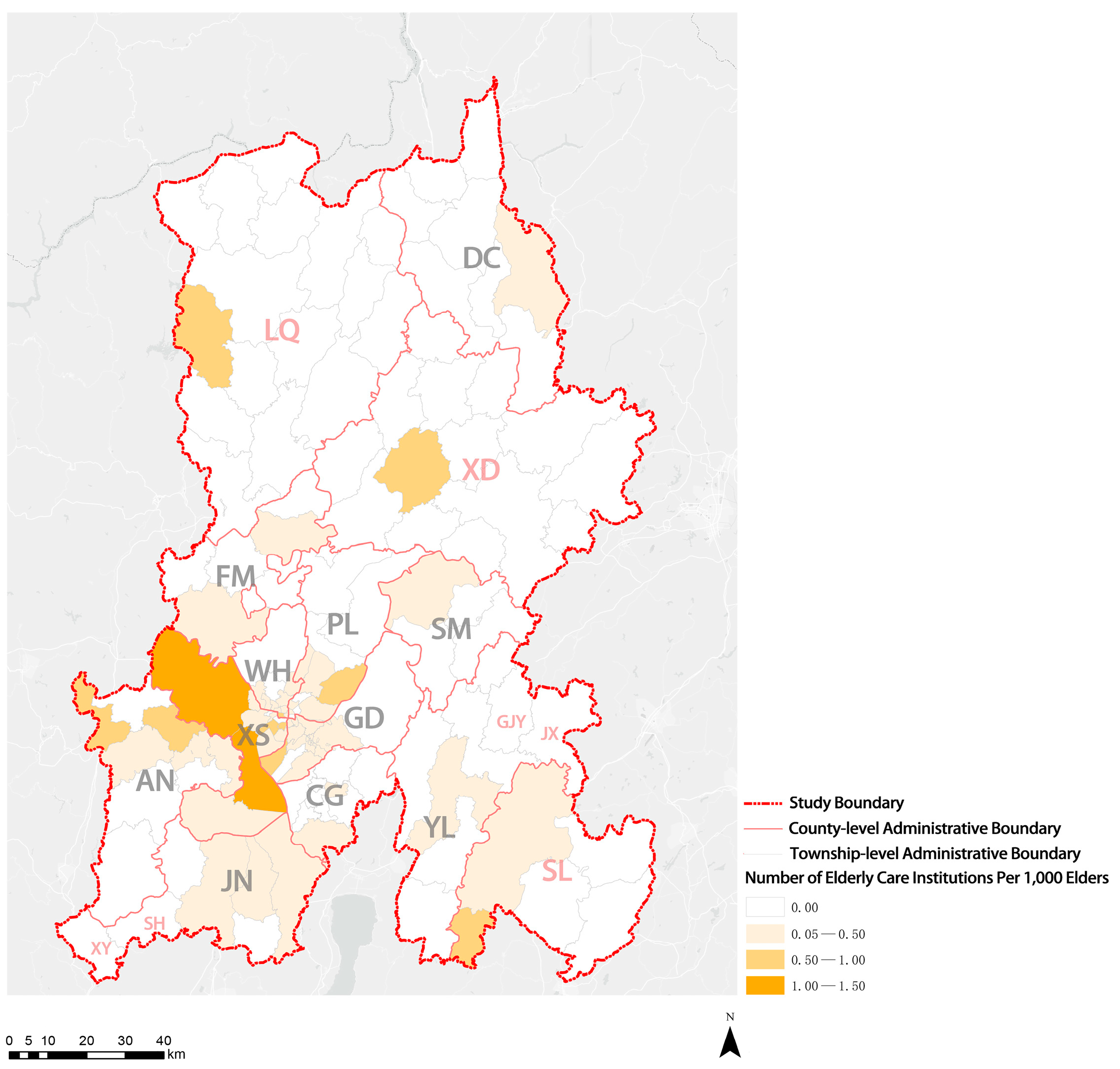

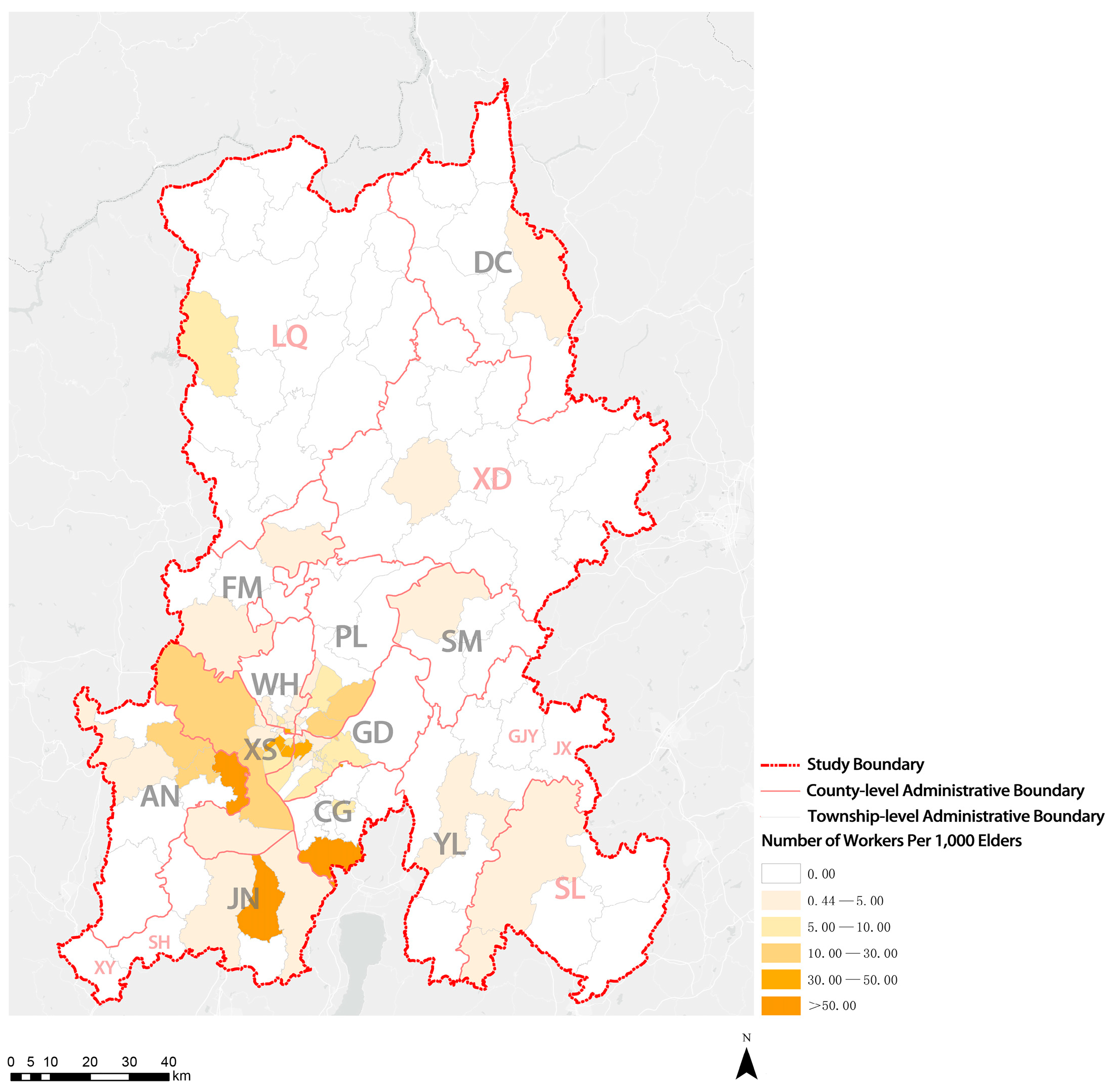
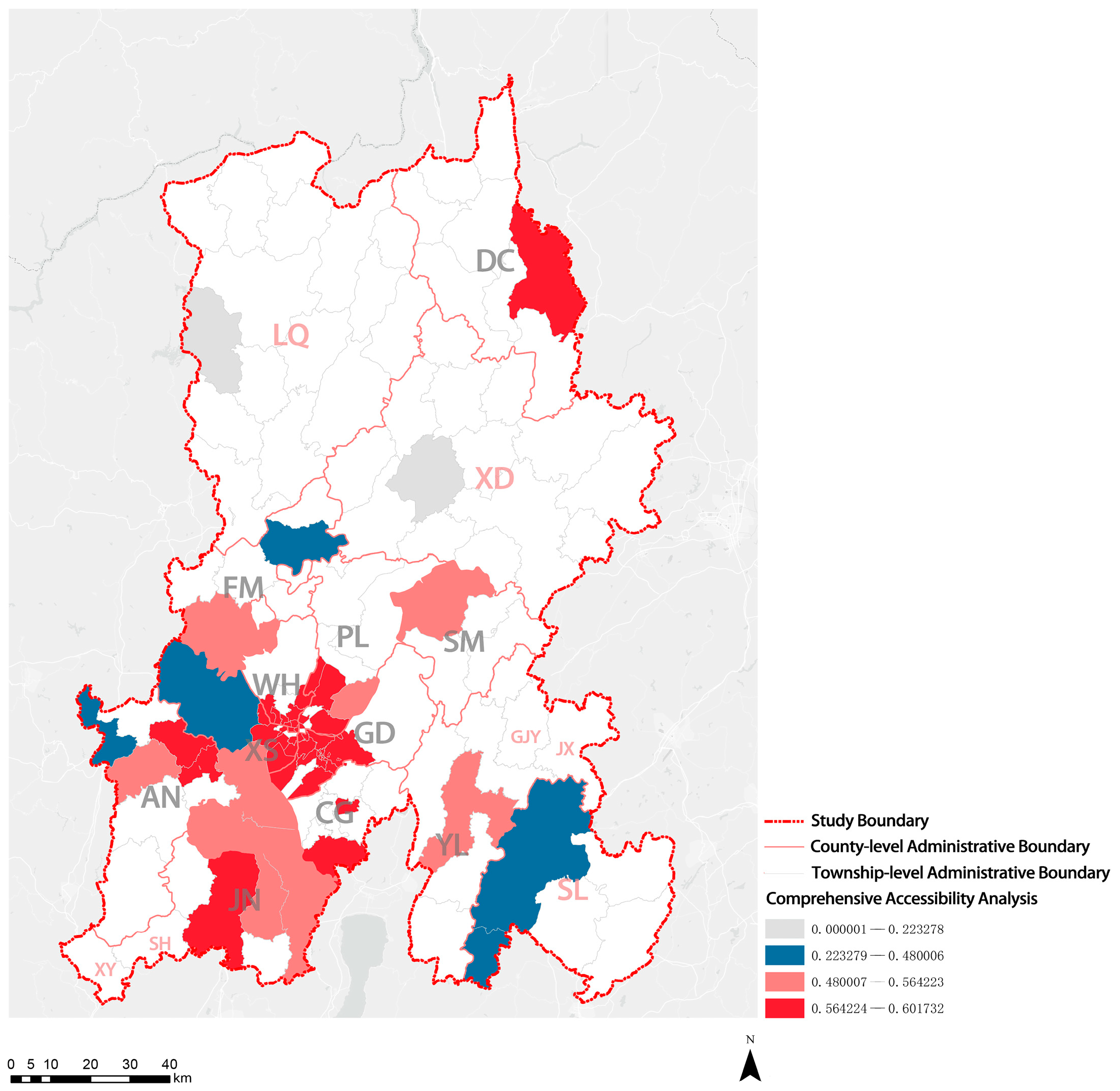
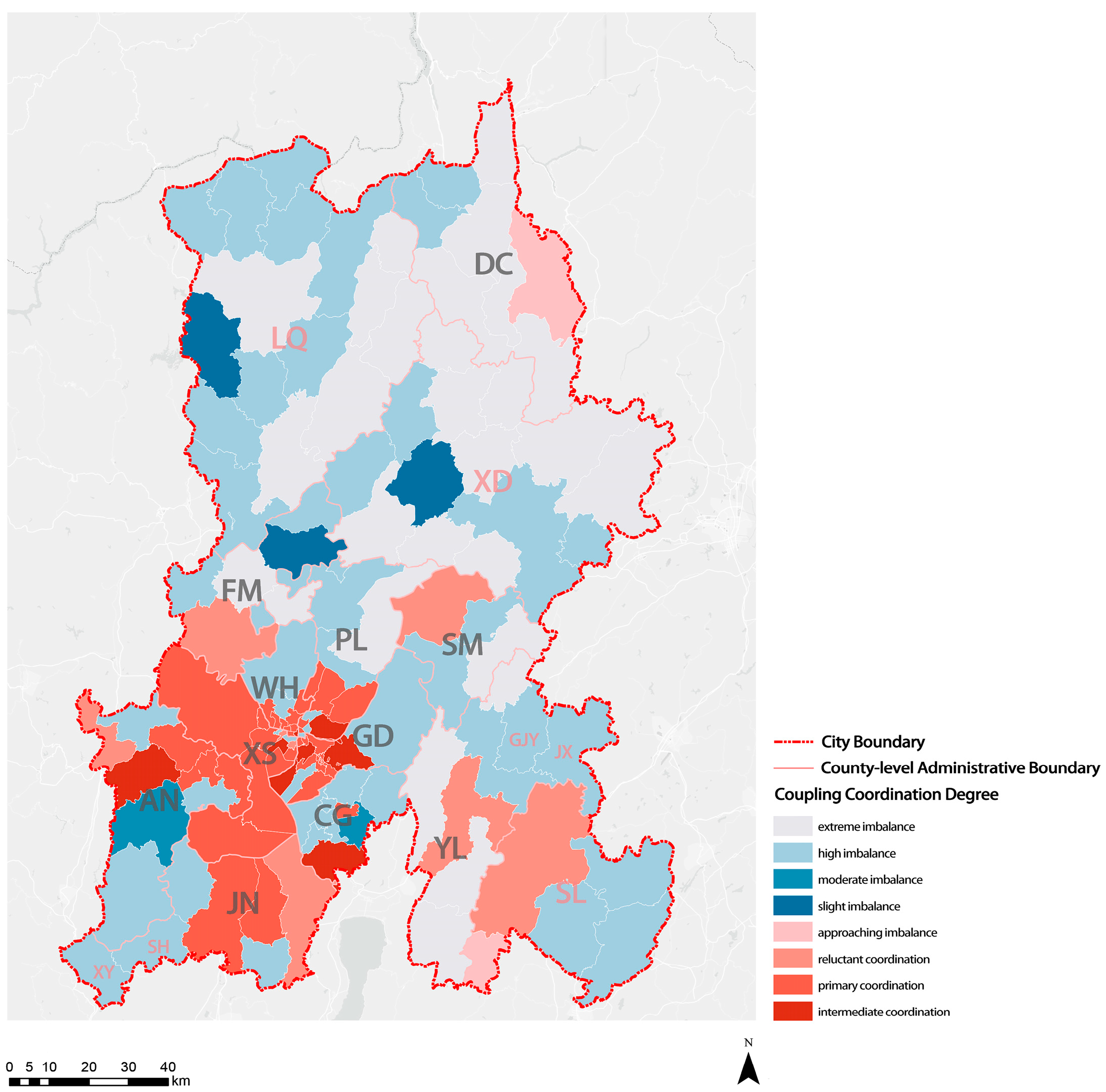
| Administrative District Institution Type | Social Welfare Institution | Nursing Home | Adult Home | Independent Living Apartment | Sanatorium | Continuing Care Retirement Community | Retirement Home | Assisted Living | Others | Total |
|---|---|---|---|---|---|---|---|---|---|---|
| WH District | 1 | 0 | 10 | 6 | 1 | 1 | 1 | 0 | 4 | 24 |
| PL District | 0 | 0 | 7 | 3 | 0 | 0 | 1 | 1 | 1 | 13 |
| GD District | 0 | 1 | 9 | 12 | 0 | 0 | 0 | 0 | 5 | 27 |
| XS District | 0 | 0 | 18 | 9 | 1 | 0 | 4 | 0 | 6 | 38 |
| DC District | 1 | 0 | 0 | 0 | 0 | 0 | 1 | 0 | 0 | 2 |
| CG District | 0 | 0 | 1 | 0 | 0 | 0 | 0 | 1 | 0 | 2 |
| JN District | 0 | 0 | 1 | 0 | 0 | 0 | 1 | 1 | 0 | 3 |
| FM County | 0 | 0 | 2 | 0 | 0 | 0 | 0 | 0 | 0 | 2 |
| YL County | 0 | 0 | 0 | 0 | 0 | 0 | 1 | 0 | 0 | 1 |
| SM County | 0 | 0 | 2 | 0 | 0 | 0 | 0 | 0 | 0 | 2 |
| SL Autonomous County | 0 | 0 | 2 | 0 | 0 | 0 | 0 | 0 | 1 | 3 |
| LQ Autonomous County | 0 | 0 | 1 | 0 | 0 | 0 | 0 | 0 | 0 | 1 |
| XD Autonomous County | 1 | 0 | 0 | 0 | 0 | 0 | 0 | 0 | 0 | 1 |
| AN County-Level City | 0 | 0 | 2 | 1 | 1 | 0 | 0 | 0 | 3 | 7 |
| Total | 3 | 1 | 55 | 31 | 3 | 1 | 9 | 3 | 20 | 126 |
| Administrative Districts | Organization Type | Care Type | ||||||||||
|---|---|---|---|---|---|---|---|---|---|---|---|---|
| State-Run | Privately Owned | Others | Total | I | II | III | IV | V | VI | VII | Total | |
| WH District | 11 | 12 | 1 | 24 | 19 | 1 | 1 | 0 | 0 | 2 | 1 | 24 |
| PL District | 4 | 9 | 0 | 13 | 7 | 1 | 3 | 0 | 1 | 1 | 0 | 13 |
| GD District | 7 | 20 | 0 | 27 | 16 | 0 | 2 | 1 | 1 | 6 | 1 | 27 |
| XS District | 14 | 24 | 0 | 38 | 23 | 1 | 5 | 0 | 0 | 5 | 4 | 38 |
| DC District | 2 | 0 | 0 | 2 | 1 | 0 | 0 | 0 | 1 | 0 | 0 | 2 |
| CG District | 1 | 1 | 0 | 2 | 1 | 0 | 0 | 0 | 0 | 0 | 1 | 2 |
| JN District | 1 | 2 | 0 | 3 | 1 | 0 | 0 | 0 | 0 | 1 | 1 | 3 |
| FM County | 2 | 0 | 0 | 2 | 2 | 0 | 0 | 0 | 0 | 0 | 0 | 2 |
| YL County | 1 | 0 | 0 | 1 | 1 | 0 | 0 | 0 | 0 | 0 | 0 | 1 |
| SM County | 2 | 0 | 0 | 2 | 2 | 0 | 0 | 0 | 0 | 0 | 0 | 2 |
| SL Autonomous County | 2 | 1 | 0 | 3 | 2 | 1 | 0 | 0 | 0 | 0 | 0 | 3 |
| LQ Autonomous County | 1 | 0 | 0 | 1 | 1 | 0 | 0 | 0 | 0 | 0 | 0 | 1 |
| XD Autonomous County | 1 | 0 | 0 | 1 | 1 | 0 | 0 | 0 | 0 | 0 | 0 | 1 |
| AN County-Level Cities | 3 | 4 | 0 | 7 | 3 | 0 | 0 | 0 | 0 | 4 | 0 | 7 |
| Total | 52 | 73 | 1 | 126 | 80 | 4 | 11 | 1 | 3 | 19 | 8 | 126 |
| Service | Facility |
|---|---|
| Healthcare | General hospitals, specialized hospitals, clinics, emergency centers, disease prevention institutions, pharmacies |
| Scenic spot | Park square, scenic spot |
| Public facility | Newsstands, public telephones, public toilets, emergency shelters |
| Life service | Daily services, travel agencies, information centers, ticket offices, post offices, express services, telecommunication offices, offices, water offices, electric power offices, beauty salons, repair stations, photography and printing stores, bath and massage facilities, laundries, funeral facilities |
| Shopping service | Shopping-related places, shopping malls, convenience stores, home appliance stores, supermarkets, flower stores, pet markets, home building material markets, general markets, cultural goods stores, sporting goods stores, specialty shopping streets, clothing stores, specialty stores, personal goods stores |
| Education, science, and culture | Science, education and culture places, museums, exhibition halls, convention centers, art galleries, libraries, science and technology museums, planetariums, cultural palaces, archives, literary and artistic groups |
| Sports and leisure | Sports and leisure services, sports venues, golf-related, entertainment venues, vacation retreats, leisure venues, movie theaters |
| Transportation service | Subway stations, bus stops, drop-off, pick-up areas |
| Tier 1 Indicators | Tier 2 Indicators | Tier 3 Indicators | Weight | Data Source |
|---|---|---|---|---|
| Service level of senior care institutions | Fundamental service level | Number of elderly care institutions per 1000 elders | 0.090 | Linkolder and Elderly Care Information Network |
| Number of beds per 1000 elders | 0.102 | |||
| Number of workers per 1000 elders | 0.109 | |||
| Average price of bed and nursing care fees | 0.096 | |||
| Convenience of living | Medical service facilities | 0.075 | AMAP | |
| Green space service facilities | 0.076 | |||
| Public service facilities | 0.076 | |||
| Living service facilities | 0.075 | |||
| Shopping service facilities | 0.075 | |||
| Scientific, educational, and cultural facilities | 0.075 | |||
| Transportation service facilities | 0.076 | |||
| Sports and leisure facilities | 0.075 | |||
| Degree of population aging | Proportion of population | Percentage of population aged 0–14 | 0.094 | Data of the Seventh National Population Census |
| Percentage of population aged 15–59 | 0.353 | |||
| Proportion of population aged 60 or older | 0.141 | |||
| Elderly-to-child ratio | 0.219 | |||
| Dependency ratio | Total dependency ratio | 0.063 | ||
| Child dependency ratio | 0.048 | |||
| Elderly dependency ratio | 0.082 |
Disclaimer/Publisher’s Note: The statements, opinions and data contained in all publications are solely those of the individual author(s) and contributor(s) and not of MDPI and/or the editor(s). MDPI and/or the editor(s) disclaim responsibility for any injury to people or property resulting from any ideas, methods, instructions or products referred to in the content. |
© 2023 by the authors. Licensee MDPI, Basel, Switzerland. This article is an open access article distributed under the terms and conditions of the Creative Commons Attribution (CC BY) license (https://creativecommons.org/licenses/by/4.0/).
Share and Cite
He, H.; Chen, Y.; Liu, Y.; Gu, Y.; Gu, Y. Equity of Elderly Care Facility Allocation in a Multi-Ethnic City under the Aging Background. Int. J. Environ. Res. Public Health 2023, 20, 3291. https://doi.org/10.3390/ijerph20043291
He H, Chen Y, Liu Y, Gu Y, Gu Y. Equity of Elderly Care Facility Allocation in a Multi-Ethnic City under the Aging Background. International Journal of Environmental Research and Public Health. 2023; 20(4):3291. https://doi.org/10.3390/ijerph20043291
Chicago/Turabian StyleHe, Haolin, Yujia Chen, Yaxin Liu, Yang Gu, and Ying Gu. 2023. "Equity of Elderly Care Facility Allocation in a Multi-Ethnic City under the Aging Background" International Journal of Environmental Research and Public Health 20, no. 4: 3291. https://doi.org/10.3390/ijerph20043291
APA StyleHe, H., Chen, Y., Liu, Y., Gu, Y., & Gu, Y. (2023). Equity of Elderly Care Facility Allocation in a Multi-Ethnic City under the Aging Background. International Journal of Environmental Research and Public Health, 20(4), 3291. https://doi.org/10.3390/ijerph20043291






